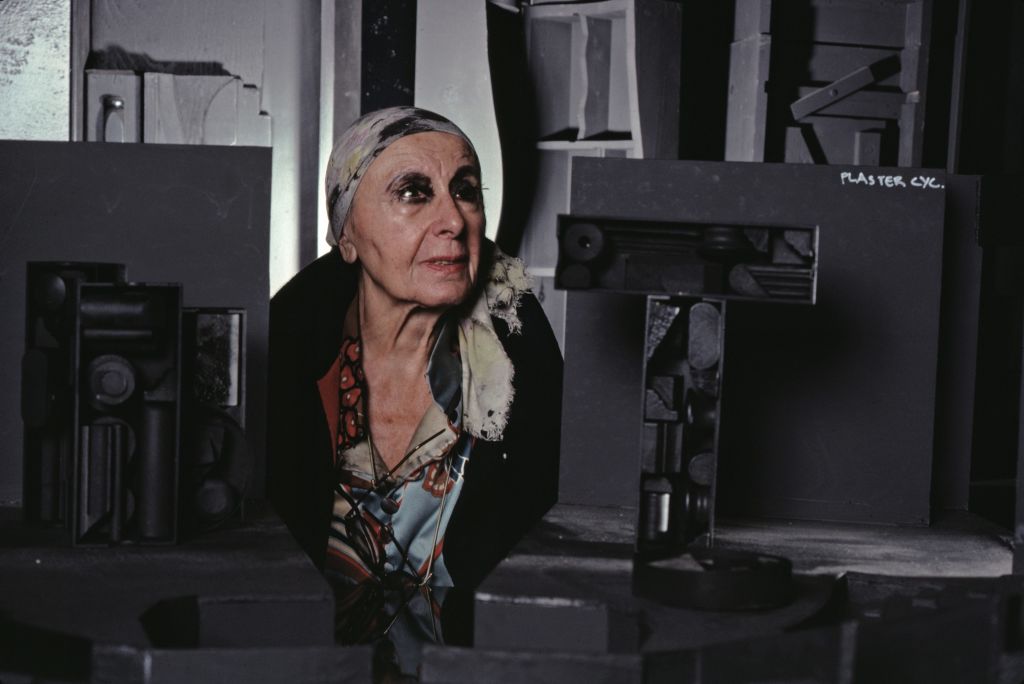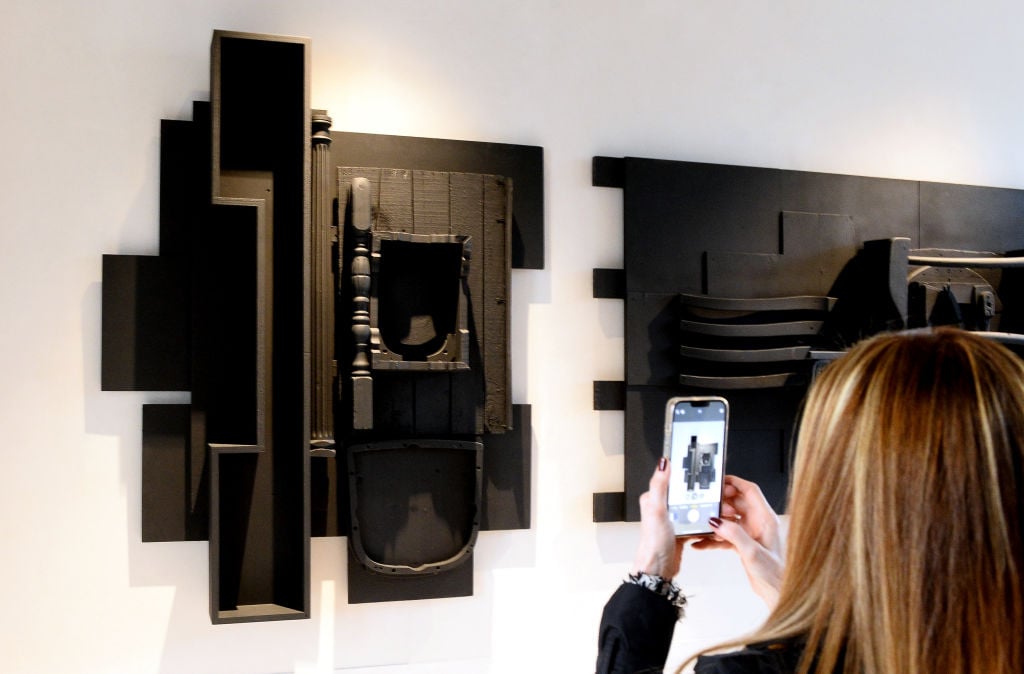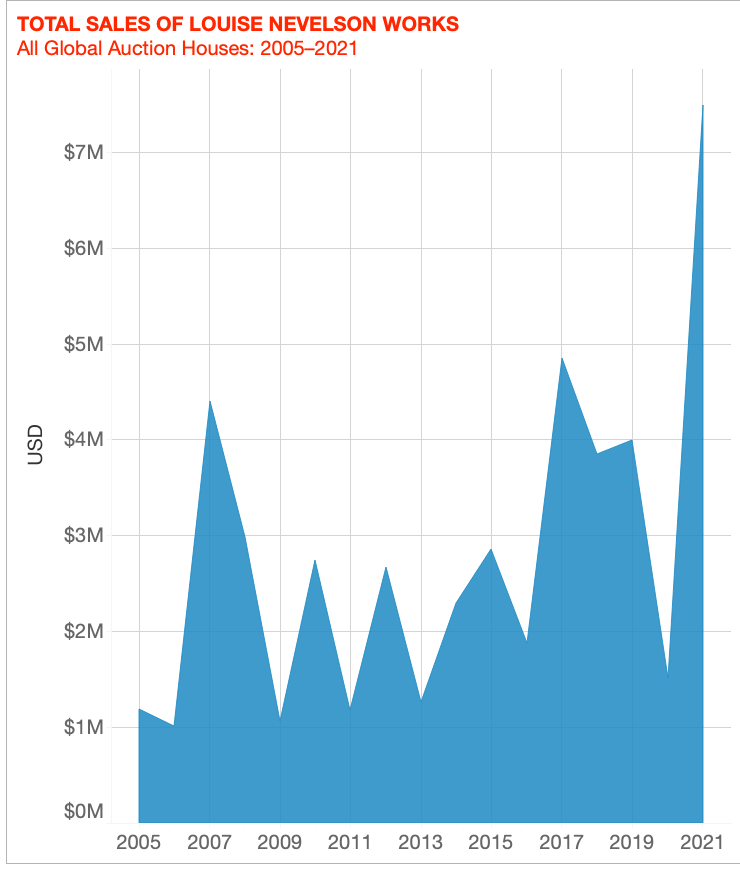The Appraisal
Louise Nevelson Was Once as Famous as Andy Warhol. Here’s Why Her Market Has Lagged So Far Behind Her Peers
A collision of factors wreaked havoc on the market for the installation art pioneer.

A collision of factors wreaked havoc on the market for the installation art pioneer.

Naomi Rea

Louise Nevelson, best known for her monochromatic painted wood sculptures, is considered one of the most important postwar artists—but her market has only recently begun to catch up.
During her lifetime, Nevelson—a woman with an incredible sense of personal style, which was also a part of her work—was as famous as Andy Warhol. In the 1960s and ‘70s, she couldn’t walk down the street without being mobbed for an autograph. An Abstract Expressionist and contemporary of Mark Rothko and Barnett Newman, Nevelson’s crucial role in the history of 20th-century art includes being an unsung pioneer of installation art, who began creating environments and walls as early as the 1940s. She also worked in collage, and made assemblages from found objects chosen for pure form, whose original identities she would obliterate with paint.
But Nevelson’s $1.4 million record, achieved just last year, lags far behind her male contemporaries. Rothko and Newman’s records stand at $86.9 million and $84.2 million, respectively (not to mention Warhol’s $195 million high-water mark). It is also far outstripped by even female contemporary Louise Bourgeois’s $32 million record.
Now, a renewed awareness of Nevelson’s legacy is beginning to have a ripple effect on her market. She is included in Cecilia Alemani’s exhibition “The Milk of Dreams” at the Venice Biennale (where, 60 years ago, she represented the U.S.), and is also the subject of an official collateral exhibition at the Procuratie Vecchie. Her market is beginning to heat up, so we dug into its history and drew from Artnet’s price database to find out what else could be driving the spike in interest.

A visitor photographing the works of American-Ukranian artist Louise Nevelson’s “Persistence” exhibition during the preview at Palazzo delle Procuratie Vecchie on April 20, 2022 in Venice, Italy. Photo by Roberto Serra – Iguana Press/Getty Images.
Auction Record: $1.4 million, achieved at Christie’s New York in May 2021
Nevelson’s Performance in 2021
Lots sold: 130
Bought in: 23
Sell-through rate: 85 percent
Average sale price: $57,604
Mean estimate: $40,139
Total sales: $7.5 million
Top painting price: $86,775
Lowest painting price: $8,125
Lowest overall price: $453, for a signed 1974 screen print from an edition of 90.

© 2022 Artnet Worldwide Corporation.

Louise Nevelson, Rain Forest Column XXI (1962-1964). Image courtesy Phillips.
While Nevelson holds an undeniably important place in art history, a seesaw of events stymied her market growth. Amid her son’s clampdown on supply to the market, there was also a shift in taste away from Nevelson’s formalist aesthetic, with interest flocking (mostly posthumously) to the more overtly feminist work of Louise Bourgeois.
Now, different currents are coming together to force a reevaluation of Nevelson’s oeuvre. There’s a renewed interest in excavating overlooked figures in art history, particularly women, and amid ballooning prices for her male Ab-Ex contemporaries, there seems to be ample opportunity in her undervalued market. One place where there is room to grow is her spectacular collages, which were shown in two galleries in the Venice show, many of which can still be acquired for under $100,000.
Prices achieved for her more domestically scaled works at the auctions in May evince the heat funneling into her secondary market. One of her columns, Rain Forest Column XXI, sold for $630,000 at Phillips’s 20th century and contemporary day sale, more than four times its upper estimate. Another column, Dream House XIV, sold at Christie’s online for $214,200, more than twice its high estimate. Other series have also been outperforming expectations: a black wall-mounted sculpture, Moon Zag X, sold at Sotheby’s contemporary day sale for $201,600, double its low estimate. At Christie’s postwar and contemporary day sale, another black sculpture, Tropical Tree X, sold for $239,400, thrice its low estimate.
All this is to say, Nevelson’s market is certainly one to watch.